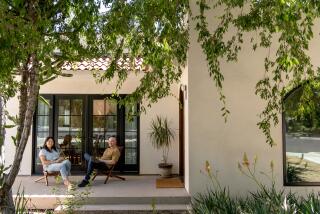Cognac Quarters
- Share via
While working in a spacious Pasadena home two years ago, interior designer Matthew White’s client asked him to take a look at a tiny space off the entry hall. “I’d been in the house a hundred times and never noticed the room,” White recalls. The 8-by-12-foot cubicle had once served as a cloakroom for the 1920s Georgian-style home but had been turned into a catchall storage closet. “She wanted some thoughts on what to do with the space.”
White blanketed the quiet retreat with paisley fabric--the perennial motif often associated with the Beatles, Peter Max and free-flowing hippie skirts of the ‘60s. In the ‘80s, pop star Prince made it his signature look, even naming his studio Paisley Park. The genesis of the Indian motif, which resembles a stylized comma, is that it’s inspired by a pine cone. Others credit the cashew fruit and its seed pod, which has been a symbol of fertility for thousands of years.
White credits a couple of sources for hatching the idea of doing something “exotic and over the top”--2001’s Tony Duquette auction of theatrical furnishings, and designer Billy Baldwin’s shirred wall treatment for New York socialite Babe Paley’s sitting room in the ‘70s. “Those two inspirations, plus clients who were game for something fun, laid the groundwork,” he says.
To transform the space, White painted moldings and doors with five coats of cinnabar-hued lacquer. A pair of flanking banquettes designed by White are sandwiched by end tables topped with hand-painted wood Indian courtiers that White turned into lamps, while a gilded camel from J.F. Chen Antiques functions as a small center table. In all, 100 yards of cotton paisley fabric cover the ceiling, walls, banquettes, lampshades, drapery, roman shade and ottoman. For the homeowners, the room resembles “a private compartment on the Orient Express.”
“It simplifies a room to have an overall pattern,” White explains. Floating in the center of the wall behind each banquette are gilt-framed mirrors designed by White and inset with Indian miniatures. “They make the room appear larger, but that wasn’t really the point,” he says. “They have so many large rooms, what the owners really needed was an intimate hideaway. They call it their ‘cognac room.’ ”
*
Resource guide
Matthew White Interior Design, Pasadena, (626) 403-1730.


